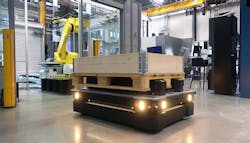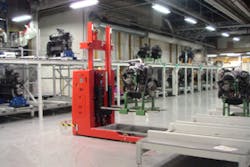Whenever use of mobile robots in industry are discussed, it’s often in warehouse automation applications. But the use of mobile robots to deliver materials from supply areas to various production workstations is beginning to boom. For example, in 2018, Automation World was able to learn about Valpak’s uses of mobile robots to deliver materials to workstations in its printing and distribution facility in St. Petersburg, Fla. Now, we’re hearing about the growing use of mobile robots in CNC applications.
Fastems, a supplier of CNC automation technologies, says the demand for its CNC automation systems that include mobile robots continues to rise. The company specializes in supplying CNC systems to high-mix, low-volume manufacturing operations, installing 4,000 such systems with more than 90 machine tool brands around the world.
Learn more about Valpak's broad use of automation in its printing and distribution operations.
“Today, the majority of our customer industries are using AGVs or AMRs in some way,” said Mika Laitinen, solution sales director at Fastems. “Whether in aerospace, defense, machine building, medical or subcontracting, there are automated vehicles in many production shops. When it comes to CNC automation and AGVs or AMRs, they can be of great help in reducing manual transfers and forklift operations, reducing buffer sizes, increasing the automation level, and making production flow more predictable and reproducible.”
Are you mobile robot ready?
If you’re thinking about adding mobile robots to automate the delivery of materials to CNC workstations in your facility, Fastems suggests referring to this checklist to help determine if your application is suitable for mobile robot use.
- Amount of transfers. Create a list of your manufacturing mix and conduct a cycle time analysis to understand how many transfers are required within a certain time period. This helps determine which kinds of mobile robots have enough capacity for your operations and how many of them you’ll need.
- Consider the load handling capacities. Here, Fastems recommends evaluating the physical interfaces between your machinery with mobile robots. This is critical as the ability to achieve the highest machine utilization possible requires the mobile robot to be able to load items into the machine. Devices for such transfers can include conveyors or robot arms for moving the parts from the AGV to the machine. Also determine whether your CNC machine is or can be equipped with an automated door for access by a robot.
- Be sure you have space to allot for a buffer storage area to avoid unnecessary work-in-process from collecting on the shop floor.
Software considerations
Mobile robot fleet management software is a key tool for creating point-to-point routes, as well as maintaining and charging the mobile robots. What these software systems lack, however, is visibility into production operations. To help address this disconnect and help users incorporate mobile robots into their CNC operations, Fastems developed its Manufacturing Management Software (MMS) to oversee all production orders, resources, and scheduling. According to Fastems, MMS schedules production based on customer orders and available production resources such as machine tools, cutting tools, and raw materials then prompts the mobile robots’ fleet management software to perform the right transfers at the right time.
To handle production planning and scheduling, MMS checks the order backlog and available production resources in NC programs, machines, tools, raw materials, and work holding. MMS then creates a production plan based on the order due dates and available production resources so that everything will be ready on time with no unnecessary work in process. The software can create detailed scheduled for up to 96 hours of operation, enabling users to assess details surrounding upcoming resource needs.
For mobile robot routes and material transfer management, the MMS tells the mobile robot fleet manager software which transfers to order and when. The fleet manager software then directs a mobile robot to make the transfer. Fastems says the communication between these software components ensures that all transfers are done just-in-time to reduce the need for large buffer storages. The software also notifies operators in advance of any missing resources to ensure everything is in place when the robot arrives.
When production changes lead to a missing resource, an urgent customer order gets expedited, or a tool or program breaks or incurs a fault, the tracking performed by MMS allows for real-time adjustments to be made to the production plan so that no unnecessary work in process is created.
About the Author
David Greenfield, editor in chief
Editor in Chief

Leaders relevant to this article:

